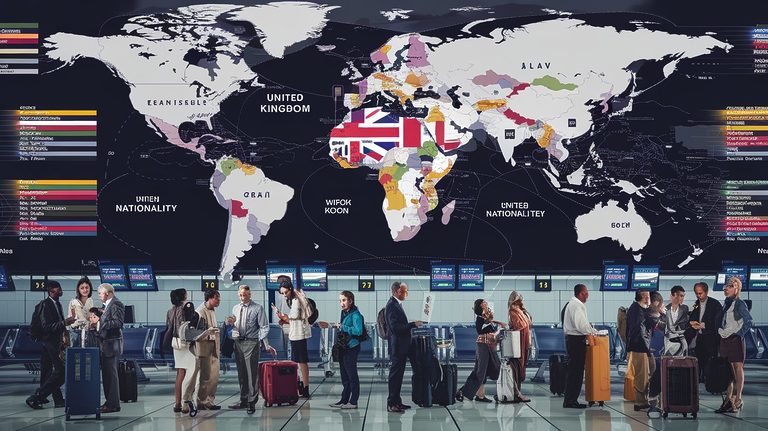The recent changes to the Electronic Travel Authorization System (ESTA) mandate that all travelers to the United States provide their sex at birth information on visa applications. Effective from January 20, 2025, this measure limits recognition to only two sexes—male and female—posed on official documents. Any mention of gender identity as seen in international passports, such as the X designation for non-binary individuals, is no longer accepted by U.S. authorities. This new directive raises significant concerns regarding the treatment of transgender and non-binary individuals at the border, underscoring the complexities travelers may face during their journeys to the U.S.
A recent directive from the United States has initiated changes to visa applications and the ESTA (Electronic Travel Authorization System), compelling travelers to provide additional information regarding their “sex at birth.” Enforced following a presidential decree on January 20, 2025, these regulations underscore a significant shift in the recognition of gender identity and its implications for international travelers. This article delves into these new mandates, their impact, and the reactions from various stakeholders.
Understanding the New Regulations
The new guidelines stipulate that the United States now officially recognizes only two sexes—male and female—as defined at birth. Consequently, all travelers must specify their sex at birth on passports, visa applications, and ESTAs to gain access to American territory. This adjustment reflects a broader trend toward a strict binary classification that has raised concerns among certain traveler demographics.
Gender Identity and Documentation
Under the new measures, gender identity as indicated on certain documents is not acknowledged by American authorities. For example, Canadian passports introduced an “X” designation for non-binary individuals in June 2019; however, this identification is not recognized in the U.S. This exclusion raises important questions regarding the validity of trans and non-binary identities as recognized on official documentation.
Potential Border Complications
Although there have been no officially confirmed incidents of border refusals specifically linked to gender identity for Canadian or French nationals, reports suggest a growing number of difficulties at U.S. borders for transgender individuals or those bearing X passports. Since these rules came into effect in late January 2025, travelers have noted more complex entry processes, which have prompted additional warnings from other nations, including Denmark and Germany, about the potential risks associated with entry into the U.S.
Responses from Advocacy Groups
Several advocacy organizations, including Amnesty International and STOP homophobie, have publicly criticized the new directive, labeling it as discriminatory. They argue that impositional requirements for indicating “sex at birth” fundamentally undermine the recognition and legitimacy of trans identities. STOP homophobie has cautioned that this restriction will likely result in arbitrary exclusions and possible refusals at U.S. borders. They are also urging European governments to challenge such practices.
Government Reactions
The Canadian government has confirmed that it is closely monitoring the unfolding situation, while also emphasizing that the decision regarding border entry remains the prerogative of individual nations. They have communicated that travelers presenting with X markers on their passports may face restrictions and that the Canadian government cannot guarantee entry into the U.S. Likewise, the French Ministry of Foreign Affairs has updated its travel recommendations, highlighting these new obligations in responses to travel queries and advising caution.
Visamundi’s Commitment to Travelers
At Visamundi, we recognize that these new regulations might pose uncertainties and concerns for travelers. Our dedicated team is committed to providing the latest information and guidance on navigating these evolving requirements for travel to the United States. We urge travelers to reach out with any questions related to visa or ESTA applications, as we aim to offer personalized support throughout the travel planning process.
For additional insights into border experiences and travel updates, please visit: American Consulate News, Visa process for Moroccan citizens, Visa updates for Lebanese citizens, Thai TM6 form, and Connections in Indian airports.
Key Points on New ESTA Application Mandates
New Requirements
- Sex at Birth: Mandatory for all visa applications and ESTAs.
- Binary Recognition: Only male and female classifications accepted.
- Passport Alignment: Must match the “sex at birth” indication.
- Presidential Decree: Effective from January 20, 2025.
Implications for Travelers
- Non-Binary Exclusion: ‘X’ marker for non-binary not recognized.
- Border Challenges: Increased scrutiny for transgender individuals.
- Government Advisories: Canada and France caution travelers.
- Legal Advocacy: Groups highlight potential discrimination risks.
The recent directive from the United States requires all visa applications and ESTA submissions to include the designation of ‘sex at birth’. This measure, effective from January 20, 2025, recognizes only two sexes: male and female, as defined at birth. Consequently, the inclusion of gender identity, such as the ‘X’ marker for non-binary individuals found on Canadian passports, is not acknowledged by U.S. authorities anymore. Advocacy groups have criticized this directive as discriminatory, urging international support for trans and non-binary individuals. Both Canadian and French foreign affairs departments have advised travelers of the potential restrictions and updated travel recommendations accordingly.

Hello! I’m Elisa, a 45-year-old travel companion with a passion for exploring new places and cultures. With years of travel experience under my belt, I thrive on creating memorable journeys for my clients. Let’s embark on an adventure together!





